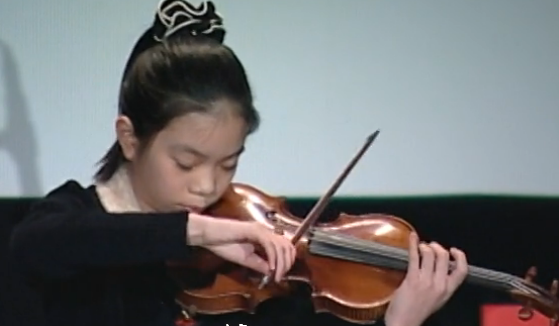Hi, everyone. I'm Sirena. I'm 11 years old and from Connecticut. Well, I'm not really sure why I'm here.
大家好,我叫黄凱珉。我今年十一岁,来自康涅狄格州。嗯,我确实不知道我为什么会在这里。
I mean, what does this have to do with technology, entertainment and design?
我的意思是,我和这些到底有什么关系,科技,娱乐和设计?
Well, I count my iPod, cellphone and computer as technology, but this has nothing to do with that.
好吧,我把我的iPod,手机和电脑都称为科技,但这都和这个(小提琴)没有关系。
So I did a little research on it. Well, this is what I found. Of course, I hope I can memorize it.
那么我做了一些研究。这是我的发现。当然,我希望我能在这里记得说出来。

The violin is made of a wood box and four metal strings.
小提琴基本上是用木头块做的。
By pulling a string, it vibrates and produces a sound wave, which passes through a piece of wood called a bridge, and goes down to the wood box and gets amplified, but ... let me think.
它有四根主弦。通过拉弦,弦产生震动。结果产生一种声波。声音通过称为琴马的木板进入木盒,然后得到放大。可是,让我想想。
On the other hand, placing your finger at different places on the fingerboard changes the string length, and that changes the frequency of the sound wave. (Sighs) Oh, my gosh!
想起来了,在另一方面,通过把手放在指板的不同位置,它改变弦的长度,这改变声波的频率。噢,我的天哪!
OK, this is sort of technology, but I can call it a 16th-century technology.
好吧,这就是所谓的科技。但我把它叫做十六世纪的科技。
But actually, the most fascinating thing that I found was that even the audio system or wave transmission nowadays are still based on the same principle of producing and projecting sound. Isn't that cool?
实际上,我发现最美妙的事是,当时称之为的声音系统,现在叫做声波的传递,现在根本上还是基于同样的原则,来产生和放大声音。这是不是很酷?












